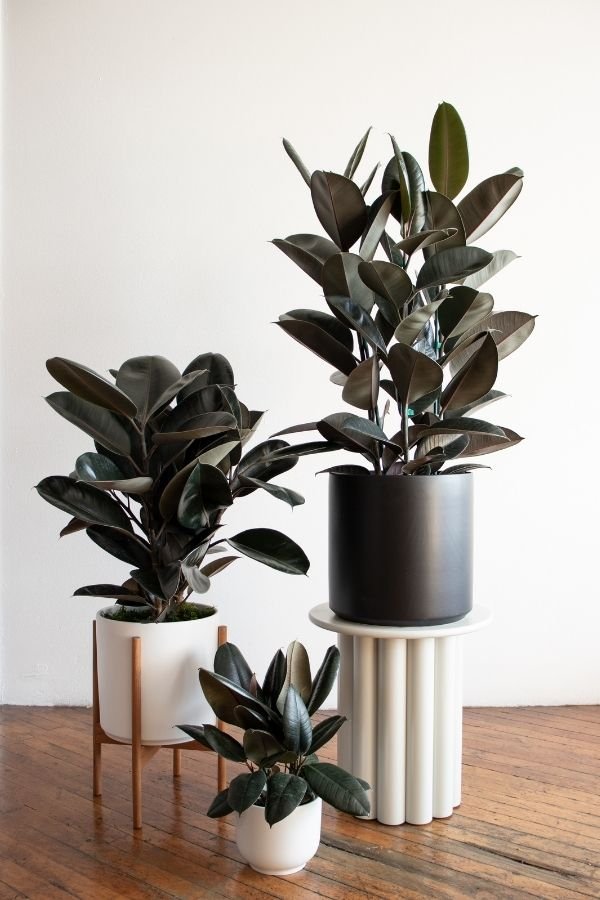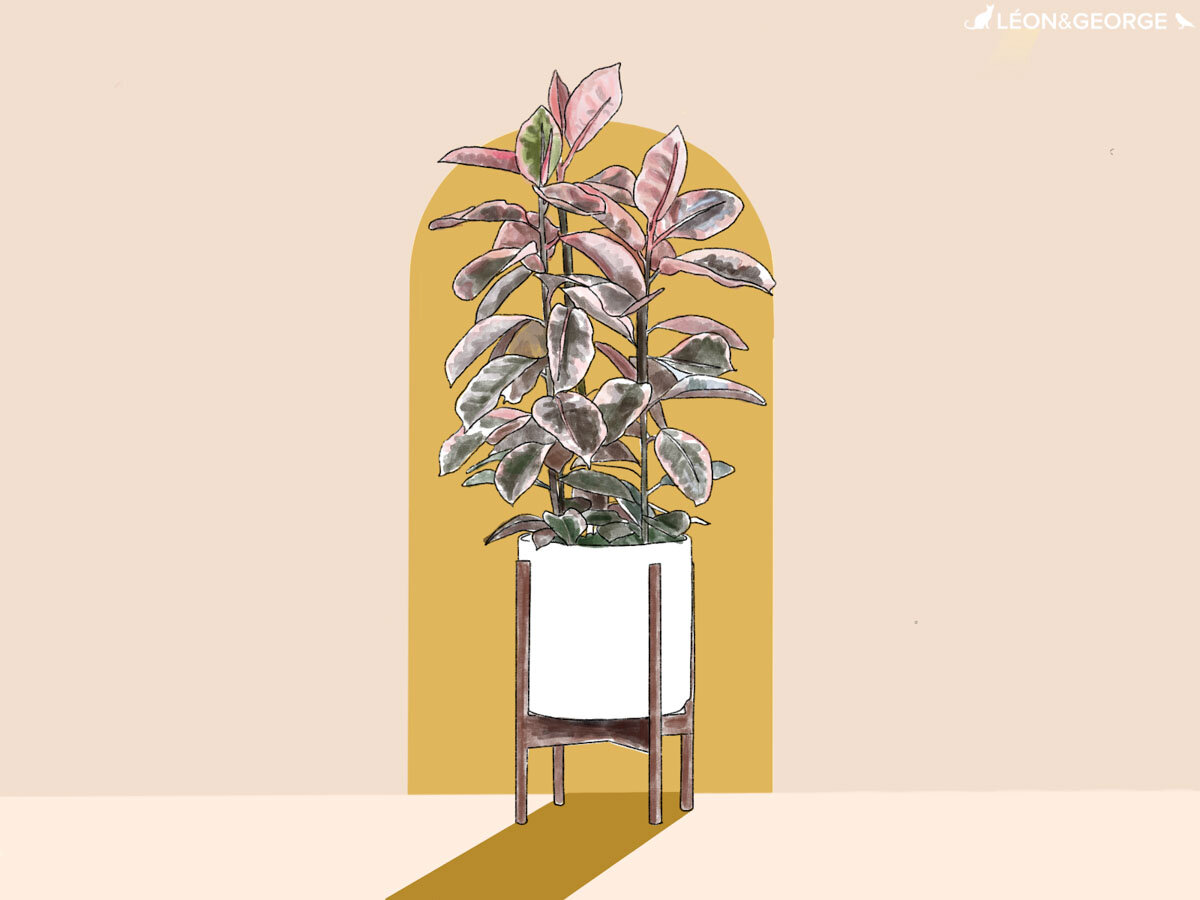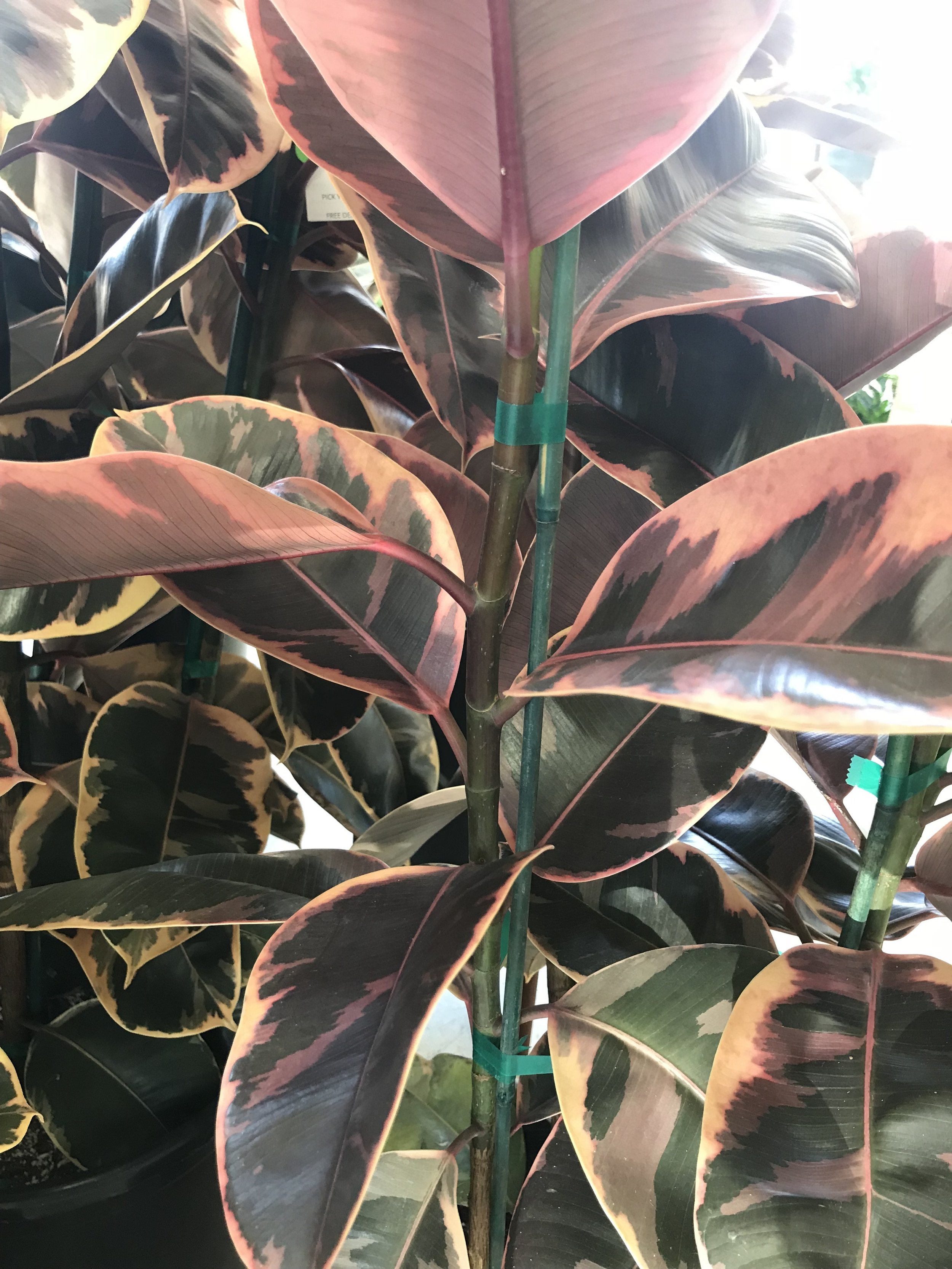Rubber Plants and trees are among the most gorgeous and eye-catching ornamental plants for indoor or outdoor placement. You’ve likely seen them used to great effect in interior decor as well as landscaping, and have probably noticed that Rubber varieties have exceptionally glossy, luxurious leaves. But you might be surprised to learn that a plant with such a luxurious look is also genuinely easy to care for. It’s true! The Rubber Plant family, or Ficus decora, doesn’t require expert plant knowledge to thrive. There are just a few simple tenets to nurturing a thriving Rubber Plant. So read on, because we’re here to fill you in on everything you need to know before you buy a Rubber Plant or tree. A ficus frenzy awaits!
There are many varieties of Rubber Plants and trees to choose from!
Who doesn’t love options? If you’re looking to buy a Rubber Plant or Rubber Tree, you have plenty of them. Ficus decora plants are available in an array of gorgeous varieties, and they all have rich, colorful foliage and, yes, those emblematic, glossy leaves you love. Our favorite of Rubber Plants and Trees are the ones with deep tone and variegation: the burgundy-tinged classic Rubber Tree and Rubber Plant, the mint and lemon toned Tineke Rubber Plant, and the strawberry hued Pink Rubber Tree and Pink Rubber Plant.
Rubber Plants and trees require medium to bright indirect sunlight
Once you’ve decided to buy your Rubber Plant, it’s time to figure out where you’ll want to put it. Although they’re flexible and can adjust to medium light, it’s a good idea to ensure that your Rubber Plant or Rubber Tree gets as much bright, indirect sunlight as possible. The light that they receive is what causes their beautiful coloration to shine, and providing a Rubber Plant with more light will mean that its hues of burgundy and pink are bright and rich. Rubber Plants kept in darker environments will exhibit less of that rosy coloring that’s so gorgeous. Consult a light guide to ensure that you place your new Rubber Plant or tree in a spot where it’ll thrive.
Where should I place my Rubber Plant?
Rubber Plants and Rubber Trees are flexible, so you’ll likely have plenty of options to choose from for plant placement. The most important things to keep in mind? Ensuring that your Rubber Plant is in a spot that receives ample, medium to bright indirect light, and protecting it from overwatering. If you like to water all of your plants in one go, it will be best to place your Rubber Plant away from any plants that require large amounts of water, so that you won’t run the risk of giving it an overdose that might be a perfect amount for a different plant species. Pairing plants that have similar watering requirements close together can be a good idea as well, and creating groupings of plants allows them to create a microbiome of moisture and humidity that they enjoy.
It’s important not to overwater your Rubber Plant or tree
This is true of all plants, but equally true of Rubber Plant and Rubber Tree varieties: they do not like to be overwatered. Rubber Plant varieties require water only when their topsoil (the top two inches of soil) are dry to the touch. Get in the habit of gauging your Rubber Plant’s moisture level by manually checking it every five to seven days. You can simply stick your finger two inches down into the plant’s soil. If that soil is dry, you can water your plant according to its care instructions. If those two inches are moist, hold off on watering until they are dry. You can also use a moisture meter as a supplemental tool to support your watering routine. They’re a great way to keep an eye on moisture levels in between manual checkups, and are easy to read. Simply check the moisture meter’s window: if it is white, the plant is ready for water, and if it is blue, the soil is still moist and does not need watering.
But overwatered Rubber Plants and trees can be corrected
We know how disappointing it is when, despite your best efforts, you overwater your plant. It can feel like a disaster, but there’s no cause for panic! Overwatered Rubber Plants and trees can be rehabilitated with a few simple steps.
The first step is to allow the Rubber Plant’s soil to dry out as soon as possible. So when you’ve identified that your Rubber Plant has been overwatered, pull it out of its ceramic pot right away, while keeping it in its plastic nursery pot. Allow the Rubber Plant or tree’s soil in the plastic nursery pot to dry out almost entirely before placing it back in the ceramic, and begin your watering routine anew. Only this time, water it only when its top two inches of soil are entirely dry to the touch. Use a moisture meter for extra support, and don’t be surprised if it reads as “moist” for a longer period of time than you’d expect. Plants living indoors typically need less frequent watering than you’d expect!
A note on toxicity in Rubber Plants and Rubber Trees
Rubber Plants and trees contain toxins in their sap. Although the toxicity of the Ficus decora is considered to be relatively mild, it is something to keep in mind if you share your space with curious pets or kids. If your heart is set on a Rubber Plant but you’re concerned about floor or tabletop placement, you can consider utilizing one as a hanging plant. They look absolutely gorgeous in hanging baskets and macrame! And if their toxicity means that a Rubber Plant or tree is a no-go for your space, don’t panic- you still have plenty of other options!
Rubber Plants and Rubber Trees love to have their leaves cleaned
Rubber Trees are native to humid environments, where moisture in the air does the work to keep those glossy, shiny leaves clean. Plan on misting your Rubber Plant or tree every week or so with either plain water or a mixture of water and a nutrient-rich foliar feed. Allow the plant to enjoy the spritz, then wipe your Rubber Plant’s leaves with a soft cloth to remove any dust. This ensures that their leaves maintain their super-glossy aesthetic, and it helps the plant photosynthesize, which ensures that its foliage maintains vibrant coloration.
Where to place your Rubber Plant or Rubber Tree
Understanding the amount of light that your space receives will help demystify the decision of where to place your Rubber Plant or Tree. Seeking an air-purifying boost? You can’t go wrong with placing a Rubber Plant or tree in a spot where you love optimal air quality. If you suffer from asthma or allergies, bedroom placement is a great idea. Ficus decora produces more oxygen than almost any other ornamental plant! They’re also renowned for removing up to 60% of mold spores and bacteria from the air. And if you’re looking to get the most bright, vibrant foliage possible from your Rubber Plant, make sure to place it in a room that receives lots of sunlight.
How to select a thriving, gorgeous Rubber Plant or tree
There are always a few things to look out for as you shop in order to ensure that you select the perfect plant for your home. In the case of Rubber Plant varieties, that means that you’ll want to carefully inspect the plant’s overall foliage. Healthy Rubber Plants in prime condition will exhibit little discoloration on their foliage: they won’t have many leaves that have brown or yellow edges. Additionally, the leaves, stems and trunks of healthy Rubber Plants and trees will have a firm texture and strong limbs, and will not appear floppy or exhausted. Prime Rubber Plant foliage will be abundant and glossy, and will not feel dry to the touch.
Avoid purchasing Rubber Plants or Rubber Trees from a garden center
To ensure a lifetime of great health and a beautiful appearance, it is essential to buy any living plant from a premium grower. A new Rubber Plant or tree means that you’re investing both money and time in acquiring a gorgeous new plant friend, and you should choose the vendor that you purchase your plant from with care.
Shopping for plants can often mean a little bit of sticker shock, and the prices at garden centers and home improvement stores can be very appealing. But it’s crucial to keep in mind that these companies are able to keep their prices low for a reason, and the quality of the plants that they offer will reflect the low price.
Garden centers and home improvement stores tend to operate by treating all of their plants the same, even when they have wildly different care requirements- as living plants often do. (They’re unique, after all!) When garden centers and home improvement stores use a one-size-fits-all approach to caring for their crop of plants, it often results in plants becoming overwatered and receiving incorrect light- both of which are issues that you can easily avoid by buying your new Rubber Plant or tree from a trusted grower.
It’s next to impossible to know for sure how a garden center or home improvement store cares for their plants, but when you purchase from a premium supplier, you have a wealth of information at your fingertips. Premium suppliers are happy to explain the details of how they care for their crops and can speak to the way that they water, the light they provide their plants, and the environments they grow them in. Additionally, premium growers treat plants prophylactically and as needed for pests, funguses and other ailments. This is essential, because insects have a frustrating habit of hopping from plant to plant, and funguses and viruses tend to spread- so if you can’t guarantee that the business you’re buying your new plant from is proactive in preventing these issues, there is a chance of bringing a pest or disease-ridden plant into your space, where it will spread to your other plants. We’ve seen it happen, and it’s a huge headache you’re better off avoiding.
Another important point to consider is the issue of transit. Rubber Plants are resilient, but all living plants are vulnerable to stress and damage from transportation and significant environmental shifts. Buying a plant from a garden center or home improvement store involves many more factors that you might realize: from fluctuations in light to the risk of structural and foliage damage to the danger of shock from temperature changes and A.Cs. Plan on buying your new Rubber Plant or Rubber Tree from a premium supplier that offers doorstep delivery, and/or ships using packaging that is custom-engineered for plants. We guarantee you’ll be glad that you did! Then lean back, and enjoy the confidence of knowing that your plant has been amply protected for its journey, and well cared for leading up to it. It is worth it to protect your investment.
Even the healthiest Rubber Plant can experience stress from time to time
Stumbles can happen along the way with any living plant, even when it receives perfect care. But there’s no need to fret: issues are typically easily revolved with just a few tweaks in your plant care routine. At Léon & George, we offer lifelong access to our Plant Doctor service with every plant purchased. That means that our team of expert horticulturalists is available to provide assessments, tips and adjustments to your plant care routine as needed, and to generally support you as you care for your plants. There’s no catch! No fees are required. Free access to the Plant Doctor service is just one of the ways that we ensure that every plant purchased from us is designed to thrive.
We’ve compiled a list of common problems that Rubber Plants and trees can face, as well as helpful guidance for assessing your plant’s health. Informed and impassioned plant parents are the key to our success! Click here to learn more about how to care for and grow your new Rubber Plant.
Glossy, Luxurious and Colorful: The Rubber Plant Collection from Léon & George
Explore our selection of stunning and low-maintenance Rubber Plants and trees. From the classic, burgundy Rubber Tree to the rosy, charming Rubber Plant, our array of thriving Ficus decora varieties offer every easy care Rubber Plant variety your heart desires!














